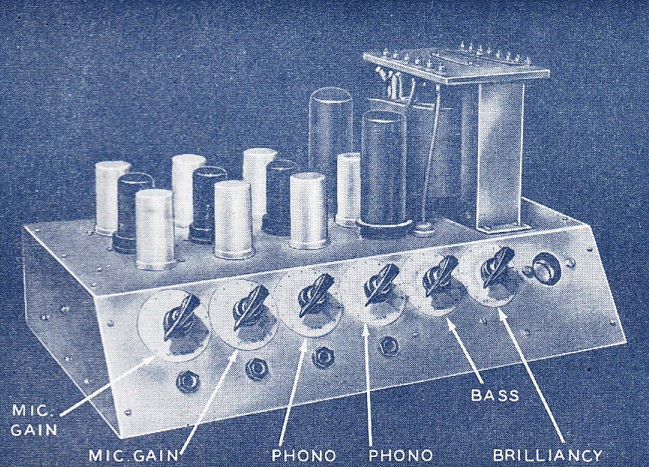 From Radio-Electronics, 1950, comes this circuit by one James Rundo. Download the article by clicking here:
From Radio-Electronics, 1950, comes this circuit by one James Rundo. Download the article by clicking here:
DOWNLOAD: HiGainPA_Amp_1950
 Above, the circuit. The front-end is set up for very low-impedance unbalanced mics that mix through a resistor network through a single (VERY) high ratio input transformer; so that bit is not very useful. What makes this piece of interest is the unusual tone control scheme. See the article for the details. Could make for a really unique guitar or studio bass amp.
Above, the circuit. The front-end is set up for very low-impedance unbalanced mics that mix through a resistor network through a single (VERY) high ratio input transformer; so that bit is not very useful. What makes this piece of interest is the unusual tone control scheme. See the article for the details. Could make for a really unique guitar or studio bass amp.
4 replies on “Hi-Gain PA Amplifier Circa 1950”
It would be nice to have a full set of those magazines either paper or on good .pdfs…But most of the audio projects were pro forma like this one. The columns and ads are the interesting part to me. Millett has a nice book chock full of these forties PA amp/mixer/mic pre type things on his site if that’s your thing, but there is a reason most people gut out these Websters and Newcombs and put Fender circuits in them.
The Baxandall tone control was the last word until you get into full parametric or graphic EQ. Ampeg used it in their guitar amps. Fender used simpler circuits that are good for making guitars sound like people want guitars to sound, unless they are going for the Les Paul or Hank Marvin thing.
What’s the neon bulb across the primary for? Can you even get those any more?
One bad feature of this project as shown in the photos is the transformer with the hook up terminals on the top. Common in old British and Australian practice, it’s not a very safe or ergonomic practice.
That Neon, with the current limiting resistors, was most likely a peak power indicator. It flashes on program peaks, and is likely calibrated to illuminate whenever the amplifier power passes 50%. This is similar to a design with the Fisher AZ-80, the latter being improved with a potentiometer to enable calibration of the neon lamp’s turn on threshold.